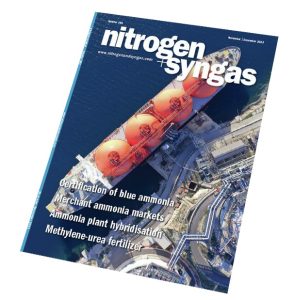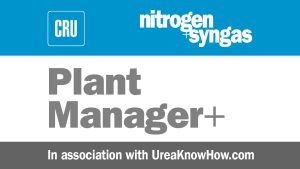
Constraints on renewable production
With low carbon ammonia and methanol being considered not just for their chemical and fertilizer uses, but as fuels, can we make enough of them to fill our energy needs?

With low carbon ammonia and methanol being considered not just for their chemical and fertilizer uses, but as fuels, can we make enough of them to fill our energy needs?

Proman has signed a memorandum of understanding (MoU) with Mitsubishi Corp to collaborate on the development of a blue ammonia plant at Lake Charles, Louisiana. This new facility will aim to produce around 1.2 million t/a of low carbon ammonia, making it one of the largest of its kind in the world. The plant will incorporate carbon capture and sequestration technology. Proman says that this development aligns with the company’s commitment to sustainability and reducing greenhouse gas emissions. The proposed ammonia plant will be located at Proman’s existing site in Lake Charles, adjacent to its gas-to-methanol plant, which is also currently being developed.

While the world’s attention has been grabbed by the terrible situation in the Middle East, the Russian-Ukrainian conflict continues to drag on. Of particular concern in recent months has been the deal to allow export of grain from Odessa, which lapsed in July 2023, a year after it first began. The deal had allowed 33 million tonnes of grain to be exported, around 60% of it to the developing world. However, Russia had always insisted that continuing with the deal was contingent on (a) a resumption of Russian ammonia exports via Odessa and (b) removing SWIFT payment restrictions on the Rosselkhozbank agricultural bank, allowing easier export of fertilizer. Fertilizers remain exempt from sanctions on Russia, but the difficulty in securing payment, the closure of the ammonia pipeline to the Black Sea, and high maritime insurance rates for traversing the Black Sea have made exports much more difficult. And although Ukraine continues to export grain, now mostly via rail to ports like Ismail and Reni on the River Danube, Russia has done its best to disrupt this, striking ports and warehouses and laying mines in shipping lanes. Around 300,000 tonnes of grain has been destroyed, according to Ukraine, as well as up to three ships hit by mines and one possibly by a missile on November 8th. Furthermore, bottlenecks in rail transit and port capacity and the difficulty in getting ships to the ports mean that actual volumes of grain exported are considerably reduced, with only around 700,000 tonnes exported via the Danube Ports from August to the start of November.

Rohit Khurana and Umesh Jainker of KBR presented a technical paper on this topic during the 2013 Asian Nitrogen + Syngas Conference. It can be found in the UreaKnowHow.com E-Library with the title: ”Replacing ammonia plant catalyst with maximum efficiency and lowest cost”. The paper addresses the importance of de-dusting catalyst beds before commissioning and the serious impacts on the plant if not performed thoroughly. Many ammonia plants have faced problems related to the plugging of exchangers, pipe choking, pressure drop increase of the downstream catalyst beds and separators or foaming in the CO 2 removal section which could be caused by the presence of catalyst dust. Most of these problems have led to either decrease in the efficiency of the plant or operation at lower throughputs. The paper presents the critical steps and procedures for proper dedusting of the catalyst beds before commissioning. In addition, the foaming problem in the CO 2 removal section associated with catalyst dust is discussed signifying the importance of cleaning the CO 2 removal system and solution. The role of filters in the CO 2 removal section was also emphasised.

Low carbon production is attracting considerable attention to using syngas derivatives as fuels, but there are considerable logistical and commercial barriers to overcome.
SunGas Renewables Inc. has formed a new subsidiary, Beaver Lake Renewable Energy, LLC (BLRE), to construct a new green methanol production facility in central Louisiana. The project will have a capacity of 400,000 t/a of green methanol, using gasified biomass, specifically wood fibre from local, sustainably-managed forests as feedstock. The methanol will have a negative carbon intensity through sequestration of the nearly 1.0 million t/a of carbon dioxide produced by the project, which will be executed by Denbury Carbon Solutions. The methanol will then be used as a clean marine fuel by A.P. Moller–Maersk, which is building a fleet of methanol-powered container vessels.

Market Insight courtesy of Argus Media

CF Fertilisers UK Limited, a subsidiary of CF Industries, says that it plans to permanently close the ammonia plant at its Billingham fertilizer complex in order to secure the long-term sustainability of its business in the UK. The Company intends to continue to produce ammonium nitrate (AN) fertiliser and nitric acid at the Billingham site using imported ammonia, as it has for the last 10 months following its decision to temporarily idle the plant in August 2022.
The CO2 emissions in a hydrocarbon fed hydrogen plant occur largely during the energy intensive syngas production step. Hydrogen production is therefore a major factor in the CO2 emission balance of an ammonia plant. BASF’s OASE® technologies for CO2 capture are capable of achieving cost-effective 99.99% carbon capture at scale. In this article Elena Petriaeva and Bernhard Geis of BASF investigate different grey and blue hydrogen production technologies.

Sustainable aviation fuel (SAF) is increasingly seen as a vital tool in the aviation sector’s transition to net zero. These drop-in fuels, which can be derived from bio and renewable-derived syngas, are used to dilute the fossil-derived components of fuel and are fully compatible with existing fuel infrastructure. This positions SAF as a convenient and rapid route towards decarbonisation. However, questions remain around its ultimate viability at scale and whether it really can be the ‘silver bullet’ aviation leaders are looking for. We spoke to Paul Ticehurst from Johnson Matthey (JM) to shed some light on SAF and the future role of syngas in aviation.